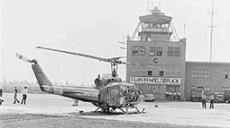Olympia 1972

Modernes Fürstenfeldbruck, um 1965, Museum Fürstenfeldbruck

Eröffnung der S-Bahn-Stammstrecke, April 1972, Wolfgang Pulfer
Die Olympischen Spiele von 1972, die sich 2022 zum 50. Mal jähren, haben die Region um München geprägt und verändert. Von dem sportlichen und kulturellen Großereignis gingen starke Modernisierungsimpulse aus. Stadt und Umland wuchsen immer stärker zusammen. Die Nachkriegszeit wurde nun von den Zeitgenoss:innen definitiv als beendet wahrgenommen.
Neue Kommunikationsformen, veränderte Mobilität durch die S-Bahnen, die die Metropole München mit den umliegenden, nun zu Trabantenstädten sich formenden Gemeinden verband, neue Marketingmechanismen, die demographische Entwicklung und die mit den Spielen verbundenen Internationalisierungsprozesse – all dies wirkte sich auch für die Entwicklung des Münchner „Speckgürtels“ katalysatorisch und modernisierend aus.

Fliegerhorst Fürstenfeldbruck, 6. September 1972, Schmotz Archiv Fürstenfeldbrucker Tagblatt
Für Fürstenfeldbruck haben die Olympischen Spiele von 1972 eine ganz besondere Bedeutung: Am 5. September fanden die „heiteren Spiele“ mit dem Attentat auf die israelische Mannschaft jäh ihr Ende. Auf dem Flugfeld des Fliegerhorstes endete der Befreiungsversuch für die neun Geiseln und einen Polizisten tödlich. 17 Menschen starben bei dem Terrorakt. Das dramatische Ereignis hat sich bis heute tief in das kollektive Gedächtnis eingegraben.
Museum und Stadt Fürstenfeldbruck erinnern vom 1. September bis zum 23. Oktober 2022 an den Ringer Mark Slavin.
Eine Lichtinstallation und eine Informationsstele zu Mark Slavin vor dem Museum nehmen Bezug auf die Ausstellung „Olympia 1972“, die bis 23. Oktober 2022 im Museum/Kunsthaus Fürstenfeldbruck zu sehen ist.
Mark Slavin größter Traum war es, Israel als Sportler bei den Olympischen Spielen in München vertreten zu dürfen. Er wuchs im sowjetrussischen Minsk auf und wurde mit 17 Jahren jüngster russischer Champion im griechisch-römischen Ringkampf. Aufgrund zunehmender antisemitischer Repressalien wanderte er im Mai 1972 nach Israel aus, wo er binnen weniger Wochen zur israelischen Olympiahoffnung wurde.
Der 18jährige Ringer fieberte auf sein Olympiadebut hin, das für Dienstag, den 5. September 1972 angesetzt war. In den frühen Morgenstunden dieses Tages wurde Mark Slavin beim gescheiterten Versuch, die israelischen Geiseln auf dem Fliegerhorst Fürstenfeldbruck zu befreien, von den palästinensischen Attentätern erschossen.
The Museum and City of Fürstenfeldbruck will commemorate the wrestler Mark Slavin from September 1st to October 23rd, 2022.
A light installation and an information stele on Mark Slavin in front of the museum refer to the "Olympia 1972" exhibition, which can be seen from July 29 to October 23, 2022 in the Museum/Kunsthaus Fürstenfeldbruck.
Mark Slavin's greatest dream was to represent Israel as an athlete at the Olympic Games in Munich. He grew up in Minsk, Soviet Russia, and at the age of 17 became the youngest Russian champion in Greco-Roman wrestling. Due to increasing anti-Semitic reprisals, he emigrated to Israel in May 1972, where within a few weeks he became Israel's Olympic hopeful.
The 18-year-old wrestler was looking forward to his Olympic debut, which was scheduled for Tuesday, September 5, 1972. In the early morning hours of that day, Mark Slavin was shot dead by the Palestinian assassins during a failed attempt to free the Israeli hostages at the Fürstenfeldbruck air base.
The 1972 Olympics
50 years ago this year Munich was host to the Olympic Games, games which permanently altered and reshaped the city and its surrounding areas. The large sporting and cultural event gave a massive boost to modernisation, which in turn brought Munich and its regions ever closer together. The post-war period was now definitely over.
New ways of communication, increased mobility due to an extended train network linking the surrounding communities which were now forming satellite cities with the city of Munich, more and more sophisticated marketing tools, demographic development and the influx of international visitors to the games had a catalysing and modernising effect on the development of Munich’s affluent suburbs.
The town of Fürstenfeldbruck will doubtless never forget the 1972 Olympic Games, if for entirely different reasons. On 5 September the Israeli team was high jacked, putting a sudden and violent end to the happy games. The ensuing attempt at Fürstenfeldbruck’s military airfield to rescue the nine Israeli hostages failed catastrophically and ended in the death of all nine hostages plus one policeman. This dramatic event has remained and will continue to remain in our collective memory.
Fürstenfeldbruck’s museum is participating in this year’s memorial project commemorating the 50th anniversary of the Munich Terrorist Attack - ‘Twelve Months – Twelve Names’ – with an exhibition dedicated to the wrestler Mark Slavin (1954-1972).
For further information on the project please go to : https://www.juedisches-museum-muenchen.de/ausstellungen/vorschau
We would very much like to say thank you to all those who have brought many wonderful objects and stories to the museum to help with the upcoming exhibition.